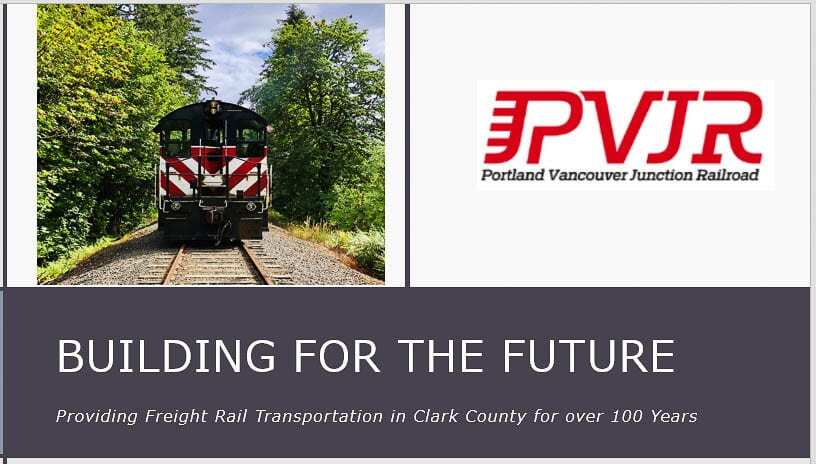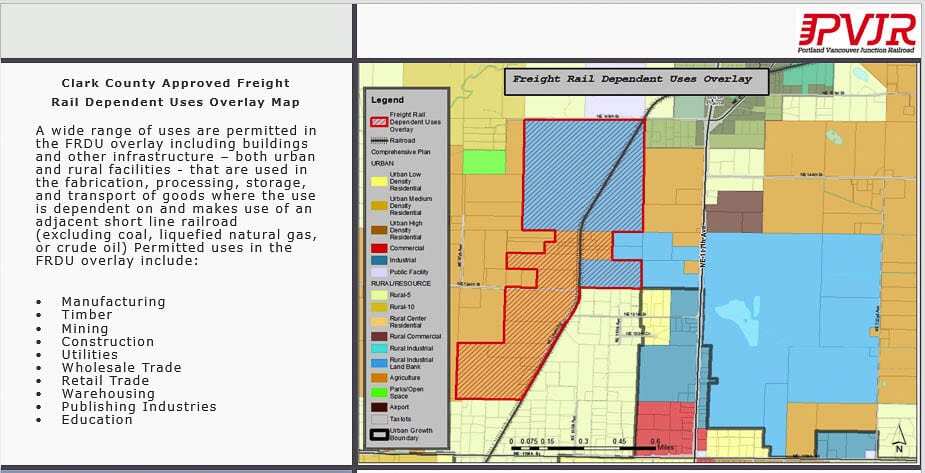Four firms with a possible 11,000 jobs have expressed interest this year
Clark County owns a 33-mile-long rail line that runs from Vancouver northeast to Yacolt. The history dates back to the late 1800s — the heyday of timber harvests and the need to transport timber to lumber mills and get the finished products to market. The line was extended following the 1902 Yacolt Burn, to salvage the timber. Could this be the key to developing thousands of modern day jobs on this side of the Columbia River?
The railroad was used for both commercial and passenger service until 1984 when its owners filed to abandon the line so they could sell the tracks, ties and right of way. Clark County purchased the line over several years, primarily during the second half of the 1980s, for commercial, tourist and recreational purposes.
Today, the Portland Vancouver Junction Railroad (PVJR) provides freight service on the portion of the line from Vancouver to Battle Ground. On the line north of Heisson, the Battle Ground, Yacolt and Chelatchie Prairie Railroad Association volunteer group, known as BYCX, operates excursion passenger trains out of Yacolt from May to December.
In 2017, Rep. Liz Pike (Republican, 18th District) introduced legislation to allow development along the rail line. It was vetoed by the governor. The hope was to attract businesses needing access to rail shipping, to create jobs along both sides of the rail line. Later during 3 special sessions of the legislature, Pike worked with Sen. Lynda Wilson (Republican, 17th District) and got a modified version of the bill passed and signed into law.

Eric Temple is the owner of the PVJR. Recently he has made multiple presentations to numerous area businesses and government agencies touting opportunities for development. He shared that in 2020, his firm received inquiries from four firms that require access to rail. They had the potential to create 500 jobs according to Temple.
So far in 2021, Temple indicates four different manufacturers have contacted the Columbia River Economic Development Council (CREDC), offering the potential for 11,000 jobs in Clark County. Interest and the number of potential jobs created is growing.
Back in 2005, a memorandum of understanding agreement was reached between the county and then-owner Columbia Basin Railroad Company. The county agreed to rezone approximately 1,400 acres of land along the rail line. They did so, but were later blocked by individuals citing the Growth Management Act (GMA).
Bruce Gryniewski, partner with Gallatin Public Affairs, shared that the county originally attempted to follow this agreement and rezoned approximately 1,400 acres in Brush Prairie. The county was sued by Futurewise to stop the development.
The court ruled the county could not de-designate this resource land and convert it to Industrial land.
The county later attempted to use another portion of the GMA called the Rural Industrial Land Bank, around 2013. This too ended with a similar result in failed litigation.
The 2017 legislation allowed for rail dependent development along this county-owned rail line in Clark County.
According to Gryniewski, since consenting to operate the Chelatchie Prairie rail line in 2003 on behalf of Clark County, the PVJR has invested over $10 million to modernize the short line railroad.
The PVJR indicates rail traffic has increased from 43 cars to over 800 cars per year. They provide rail transportation to rural Clark County businesses, supporting over 1,000 rail dependent jobs.
In 2018, the Clark County Council adopted Freight Rail Dependent Uses (FRDU) into its Comprehensive Plan and Map, according to PJVR. The FRDU overlay identifies approximately 300 acres of land for those uses that are dependent on and make use of the short line railroad.

The FRDU overlay includes parcels adjacent to the railroad and allows for urban facilities outside the Urban Growth Area, including the extension of sewer.
The FRDU overlay applies to properties within 500 feet of the county’s Chelatchie Prairie rail line between Northeast 119th and 149th streets in the Brush Prairie area, excluding land zoned R-5 or land within the Brush Prairie Rural Center.
In 2019, Clark County Today reported the legislature had approved $1.5 million for improvements to the Chelatchie Prairie Railroad. Additional funding for the Chelatchie Prairie Railroad is being discussed in the current Transportation budgets, but there is no agreement yet between House and Senate proposals.
During the original construction of the line in the late 1800’s, lighter gage steel was used, tie density per mile was lower (2800 ties per mile vs. 3,000 today), and ballast subbase was inadequate. Railcars in the 1800’s weighed 40,000 pounds while modern cars weigh 286,000 pounds. While new steel is needed, the life of the railroad can be extended by improving the subbase with replacement ties as well as additional ballast.
Temple touts the “lost opportunity” for Clark County. He showed 1,261 acres of property in Brush Prairie covered by the FRDU. His numbers cite 2018 taxes paid by the entire area as $871,750. Had there been development, Temple believes the county could have received up to a couple million dollars per acre in taxes in addition to the jobs created.
He located three new construction light industrial parcels in Clark County for comparison. The three parcels totaled 42.83 acres, sold for $108 million or $2.5 million per acre. The total taxes for two of the parcels was $773,100 for the 32.44 acres, or $23,831 per acre. At $20,000 in taxes per acre, the county could be getting over $24 million a year in property taxes for the 1,200+ acres.
Besides needing the county to approve details related to the zoning changes, there remain legal obstacles. In March of 2019, the county sued PVJR for breach of contract. They responded with a counter lawsuit a few days later against the county.
When asked to comment about the development of jobs along the county-owned rail line and PVJR, county officials refused to comment due to the litigation. Temple is hopeful that the county can recognize the value of adopting development regulations now so that economic activity and job creation can begin.




